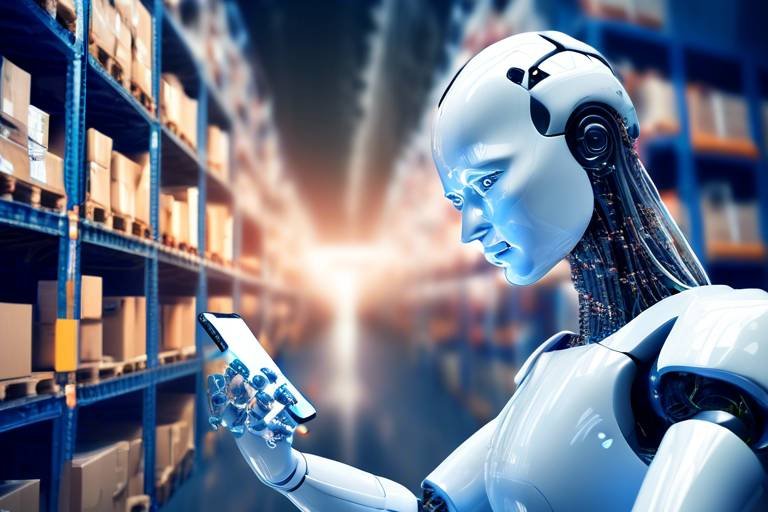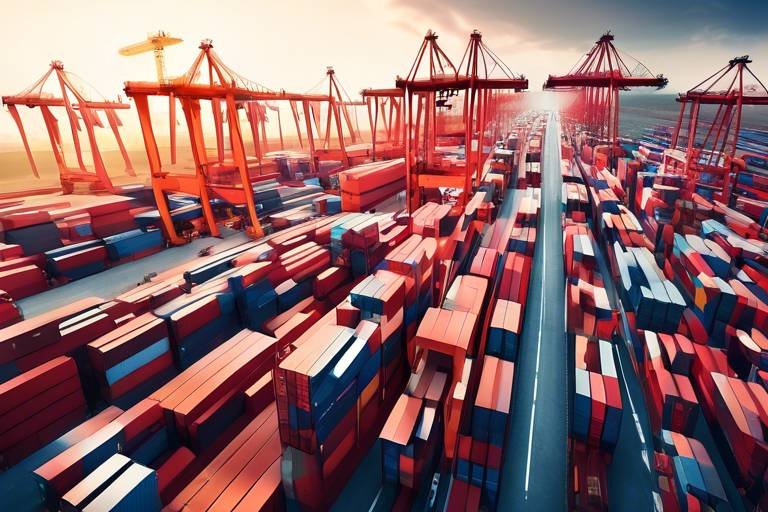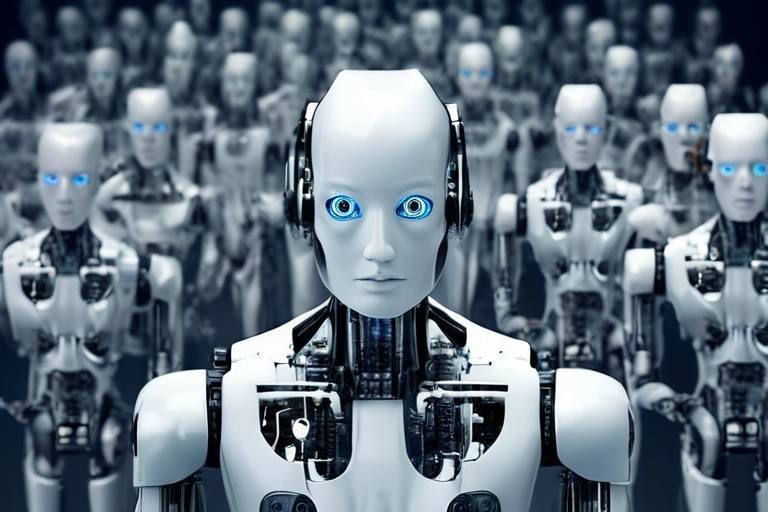The Role of AI in the Green Energy Sector
In today's world, where the urgency for sustainable solutions is more pressing than ever, artificial intelligence (AI) is emerging as a game-changer in the green energy sector. Imagine a world where energy is not just produced but is also consumed and managed intelligently, minimizing waste and maximizing efficiency. This is not just a dream; it's becoming a reality thanks to the transformative power of AI. From optimizing energy management systems to enhancing predictive maintenance in renewable energy technologies, AI is paving the way for a cleaner, greener future.
As we delve deeper into this topic, it’s essential to understand how AI is reshaping various aspects of the green energy landscape. For instance, AI technologies are being deployed to analyze vast amounts of data, allowing for smarter grid management. This means that energy can be distributed more effectively, reducing costs and enhancing overall efficiency across different sectors. Think of it as having a personal assistant who not only manages your calendar but also predicts your needs before you even ask!
The integration of AI in renewable energy technologies is not just about efficiency; it's also about innovation. With AI at the helm, we are witnessing the birth of new technologies that were once thought to be science fiction. From wind turbines that can self-optimize to solar panels that can predict energy generation based on weather patterns, the possibilities are endless. In the following sections, we will explore these innovations in detail, showcasing how AI is not just a tool but a vital partner in our journey towards sustainable energy solutions.
Discover how AI technologies are optimizing energy consumption and distribution, leading to smarter grid management and improved energy efficiency across various sectors. One of the key advantages of AI in energy management is its ability to analyze real-time data from multiple sources. This data-driven approach allows energy providers to make informed decisions that enhance operational efficiency and reduce costs.
For example, AI can predict peak energy demand periods, enabling energy providers to allocate resources more effectively. This not only leads to cost savings but also minimizes the environmental impact by reducing the need for fossil fuel-based energy generation during peak times. The result? A more sustainable energy ecosystem that benefits both consumers and the planet.
Learn about the role of AI in predictive maintenance, enabling timely interventions that reduce downtime and extend the lifespan of renewable energy equipment. Imagine a wind turbine that can predict when it will need maintenance before any issues arise. This proactive approach is made possible through AI algorithms that analyze operational data, identifying patterns and anomalies that human operators might overlook.
Explore how AI algorithms analyze data to enhance the performance and efficiency of wind turbines, maximizing energy output and reducing operational costs. By continuously monitoring variables such as wind speed, temperature, and turbine performance, AI can optimize the angle of the turbine blades in real-time, ensuring that each turbine operates at its peak efficiency.
Understand how data analytics powered by AI can identify patterns in wind behavior, leading to better site selection and operational strategies for wind farms. This means that energy companies can invest in locations where wind patterns are most favorable, significantly increasing energy production and reducing costs.
Examine the importance of real-time monitoring systems that leverage AI to detect anomalies and optimize the performance of wind energy systems. These systems can alert operators to potential issues before they escalate, ensuring that wind farms operate smoothly and efficiently.
Investigate how AI improves solar energy forecasting, helping to predict energy generation based on weather patterns and optimizing energy storage solutions. By analyzing historical weather data and real-time meteorological information, AI can provide accurate predictions of solar energy generation, allowing for better energy management and storage strategies.
Uncover how AI is advancing energy storage technologies, enabling more effective management of renewable energy sources and ensuring a stable energy supply. AI algorithms can optimize charging and discharging cycles of batteries, prolonging their life and enhancing their performance.
Delve into how AI enhances battery management systems, optimizing charging cycles and prolonging battery life for energy storage solutions. This is crucial for integrating renewable energy sources into the grid, as it allows for the storage of excess energy generated during peak production times for use during periods of high demand.
Learn about the AI-driven techniques that facilitate the integration of renewable energy sources into existing power grids, ensuring reliability and efficiency. By predicting energy supply and demand fluctuations, AI can help grid operators make informed decisions about energy distribution, ultimately leading to a more resilient energy infrastructure.
Explore how AI tools are revolutionizing environmental impact assessments, providing more accurate data for sustainable energy project planning and execution. With AI, energy companies can analyze vast datasets to evaluate the potential environmental impacts of their projects, allowing for more informed decision-making.
Understand how AI enables more precise carbon footprint analysis, helping energy companies identify areas for improvement and implement greener practices. By continuously monitoring emissions and energy consumption, AI can provide actionable insights that drive sustainability efforts.
Examine how AI assists in monitoring compliance with environmental regulations, ensuring that renewable energy projects adhere to sustainability standards. This not only helps companies avoid penalties but also fosters a culture of environmental responsibility.
- How is AI impacting the renewable energy sector? AI enhances efficiency, reduces costs, and drives innovation in renewable energy technologies.
- What are the benefits of AI in energy management? AI optimizes energy consumption, predicts demand, and improves grid management.
- Can AI help in reducing the carbon footprint? Yes, AI provides precise carbon footprint analysis and helps implement greener practices.

AI-Driven Energy Management
In today's fast-paced world, the way we manage energy is undergoing a revolutionary transformation, thanks to the remarkable capabilities of artificial intelligence (AI). Imagine a system that not only understands our energy consumption patterns but also predicts our future needs with astonishing accuracy. Sounds like science fiction, right? Well, it's becoming a reality! AI technologies are at the forefront of optimizing energy consumption and distribution, leading to what we now refer to as smarter grid management. This shift is not just about reducing costs; it’s about enhancing efficiency and driving innovation in the green energy sector.
AI-driven energy management systems analyze vast amounts of data in real-time, allowing utilities and businesses to make informed decisions that impact their energy usage. For instance, these systems can predict peak demand times and adjust the energy distribution accordingly, ensuring that resources are used efficiently and waste is minimized. This proactive approach not only saves money but also plays a crucial role in reducing the carbon footprint associated with energy production.
One of the most exciting aspects of AI in energy management is its ability to integrate with various technologies. For example, smart meters equipped with AI capabilities can provide detailed insights into energy consumption at a granular level. This means that consumers can receive tailored recommendations on how to reduce their energy usage, ultimately leading to lower bills and a more sustainable lifestyle. Imagine being able to receive alerts on your phone about your energy consumption patterns and tips on how to save energy, all thanks to AI!
Moreover, AI is instrumental in facilitating the transition to renewable energy sources. With the increasing reliance on solar and wind power, energy management systems powered by AI can optimize the integration of these intermittent energy sources into the grid. They can forecast energy generation based on weather patterns, ensuring that energy supply meets demand even when the sun isn't shining or the wind isn't blowing. This kind of adaptability is crucial for the stability of our energy systems.
As we look to the future, the role of AI in energy management will only continue to grow. With advancements in machine learning and data analytics, we can expect even more sophisticated systems that not only manage energy more effectively but also contribute to a greener planet. The potential benefits are enormous:
- Enhanced efficiency: Reducing energy waste and optimizing resource allocation.
- Cost savings: Lowering operational costs for businesses and households alike.
- Improved sustainability: Supporting the transition to renewable energy sources and minimizing carbon emissions.
In conclusion, AI-driven energy management is not just a trend; it's a fundamental shift in how we approach energy consumption and distribution. As we embrace these technologies, we pave the way for a more sustainable future, one where energy management is smarter, cleaner, and more efficient.

Predictive Maintenance in Renewable Energy
In the ever-evolving landscape of renewable energy, predictive maintenance has emerged as a game-changer. Imagine being able to foresee potential issues before they escalate into costly failures. That’s precisely what AI brings to the table. By analyzing vast amounts of data collected from renewable energy equipment, AI can pinpoint when a component is likely to fail, allowing operators to perform maintenance at just the right time. This proactive approach not only reduces downtime but also extends the lifespan of critical infrastructure, ultimately saving money and resources.
One of the standout applications of predictive maintenance is in the realm of wind energy. Wind turbines, which are often located in remote areas, can be challenging to maintain. Traditional maintenance schedules are typically based on fixed intervals, which may not align with the actual wear and tear experienced by the equipment. However, with AI, operators can use data from sensors embedded in the turbines to monitor their performance continuously. This means that maintenance can be scheduled based on the actual condition of the turbine, rather than an arbitrary timeline.
For instance, consider a scenario where a turbine's blade is showing signs of excessive vibration, which could indicate a potential failure. AI algorithms can analyze this data in real-time, alerting maintenance teams to address the issue before it leads to a complete breakdown. This not only enhances the reliability of the wind farm but also contributes to a more stable energy supply, which is crucial in today’s energy-dependent world.
The optimization of wind turbines through AI doesn’t stop at predictive maintenance. AI algorithms are adept at processing historical data and current operational metrics to enhance the overall performance of turbines. By assessing factors such as wind speed, direction, and turbine orientation, AI can recommend adjustments that maximize energy output while minimizing operational costs. This is akin to having a personal coach for each turbine, ensuring they are always performing at their best.
Data analytics plays a crucial role in the success of wind farms. AI technologies can sift through enormous datasets to identify patterns in wind behavior, which helps in selecting the best sites for new wind farms. By analyzing historical weather data and turbine performance, operators can make informed decisions that optimize energy generation. For example, if a particular site consistently experiences high wind speeds, it may be an ideal location for new turbines, leading to increased energy production.
In addition to predictive maintenance and optimization, real-time monitoring solutions powered by AI are vital for the smooth operation of renewable energy systems. These systems can detect anomalies in performance almost instantaneously, allowing for rapid response to potential issues. For instance, if a turbine begins to underperform unexpectedly, the monitoring system can alert technicians to investigate. This swift action can prevent minor issues from escalating into significant problems, ensuring that energy production remains steady and reliable.
Overall, the integration of AI in predictive maintenance not only enhances the efficiency of renewable energy systems but also supports the broader goal of sustainability. By reducing downtime and extending the life of equipment, the green energy sector can become even more viable and effective in combating climate change. As we continue to innovate and embrace these technologies, the future of renewable energy looks brighter than ever.
- What is predictive maintenance? Predictive maintenance uses data analysis tools and techniques to detect anomalies in equipment and predict failures before they occur.
- How does AI contribute to predictive maintenance? AI processes large amounts of data from sensors to identify patterns and predict when equipment is likely to fail, enabling timely maintenance.
- Why is predictive maintenance important for renewable energy? It reduces downtime, extends the lifespan of equipment, and ultimately saves costs, making renewable energy systems more efficient and reliable.

Wind Turbine Optimization
In the ever-evolving landscape of renewable energy, stands out as a critical area where artificial intelligence is making waves. Imagine a world where wind turbines not only generate energy but do so with maximum efficiency and minimal downtime. That's the promise of AI in this sector. By analyzing vast amounts of data collected from turbines, AI algorithms can pinpoint inefficiencies and suggest improvements, much like a coach analyzing game footage to enhance player performance. This technology allows us to squeeze every last drop of energy from the wind, making it a game-changer in the renewable energy arena.
One of the key benefits of AI-driven optimization is its ability to assess real-time performance data. Wind turbines are complex machines that operate in dynamic environments, where wind speed and direction can change rapidly. By employing machine learning techniques, AI can learn from historical data and current conditions to forecast optimal operational settings. This not only maximizes energy output but also helps in reducing operational costs significantly. For instance, AI can adjust the pitch of turbine blades in real time, ensuring they capture the most energy possible without exceeding mechanical limits.
Moreover, AI's role extends beyond just performance enhancement; it also plays a vital part in predictive maintenance. By continuously monitoring the health of turbine components, AI can predict potential failures before they occur. This proactive approach minimizes downtime and extends the lifespan of the turbines, akin to how regular health check-ups can prevent serious medical issues. The integration of AI in predictive maintenance strategies can lead to substantial cost savings and increased reliability in energy production.
To illustrate the impact of AI on wind turbine optimization, consider the following table that outlines key performance indicators (KPIs) before and after the implementation of AI technologies:
| Performance Indicator | Before AI Implementation | After AI Implementation |
|---|---|---|
| Energy Output (MWh) | 1,000 | 1,250 |
| Operational Downtime (%) | 15 | 5 |
| Maintenance Costs ($) | 200,000 | 150,000 |
As we can see, the implementation of AI not only boosts energy output but also significantly reduces both downtime and maintenance costs. This kind of optimization is vital as we strive to meet increasing energy demands while simultaneously addressing climate change. In a world where every kilowatt counts, the integration of AI in wind turbine operations is not just beneficial; it’s essential.
In conclusion, wind turbine optimization through AI is a fascinating blend of technology and sustainability. It transforms how we harness wind energy, ensuring that we do so in the most efficient manner possible. With ongoing advancements in AI, the future looks bright for wind energy, promising not only to meet our growing energy needs but also to do so in a way that is environmentally responsible.
- How does AI improve wind turbine efficiency?
AI improves efficiency by analyzing real-time data to optimize turbine performance and predict maintenance needs. - Can AI help in reducing operational costs?
Yes, by minimizing downtime and optimizing maintenance schedules, AI can significantly lower operational costs. - What role does data play in wind turbine optimization?
Data is crucial as it helps AI algorithms learn from past performance and adapt to current conditions for improved energy output.

Data Analytics for Wind Farms
When it comes to maximizing the output of wind farms, data analytics is the unsung hero. Imagine standing on a hill, watching the wind turbines spin gracefully in the breeze. Behind that serene image lies a complex world of data that, when harnessed effectively, can lead to unprecedented efficiency and productivity. By leveraging artificial intelligence to analyze vast amounts of data collected from wind turbines, operators can make informed decisions that enhance performance and reduce operational costs.
One of the key aspects of data analytics in wind farms is its ability to identify patterns in wind behavior. This includes understanding how wind speeds and directions fluctuate throughout the day and across different seasons. With the help of AI algorithms, operators can predict when wind conditions will be optimal for energy production. This predictive capability allows for better planning and operation of wind turbines, ensuring they are generating energy at peak efficiency.
Furthermore, data analytics can significantly improve the site selection process for new wind farms. By analyzing historical weather data and geographical information, AI can help identify the best locations for wind turbines, maximizing energy generation potential. This not only leads to higher output but also minimizes the environmental impact by ensuring that new installations are placed in areas where they can thrive.
Real-time monitoring is another critical component of data analytics for wind farms. With AI-powered systems, operators can continuously track the performance of each turbine. This includes monitoring factors such as rotational speed, temperature, and vibration levels. By detecting anomalies in real-time, operators can address issues before they lead to costly downtimes. For instance, if a turbine shows signs of wear and tear, AI can alert technicians to perform maintenance, ensuring the turbine operates smoothly and efficiently.
In summary, the integration of data analytics into wind farm operations is a game changer. It allows for:
- Enhanced performance: By understanding wind patterns and turbine functionality.
- Optimal site selection: Ensuring new installations are placed where they can generate the most energy.
- Proactive maintenance: Addressing potential issues before they escalate into major problems.
As the green energy sector continues to grow, the role of data analytics in wind farms will only become more vital. The ability to harness data not only drives innovation but also contributes to a sustainable future where renewable energy can meet the demands of an ever-evolving world.
- What is the role of data analytics in wind farms? Data analytics helps optimize the performance of wind turbines by analyzing wind behavior, improving site selection, and enabling proactive maintenance.
- How does AI contribute to wind farm efficiency? AI analyzes large datasets to identify patterns and predict optimal operating conditions, which enhances energy production and reduces costs.
- What are the benefits of real-time monitoring in wind energy? Real-time monitoring allows for immediate detection of anomalies, leading to timely maintenance and reduced downtime.

Real-Time Monitoring Solutions
In the realm of renewable energy, are becoming increasingly vital. Imagine having a watchful eye over every component of your wind energy system, ensuring that everything operates smoothly at all times. This is precisely what AI-powered monitoring systems offer. They utilize advanced algorithms and machine learning techniques to continuously analyze data from various sensors installed on wind turbines and other renewable energy infrastructures.
These systems not only track performance metrics but also detect anomalies that might indicate potential failures. For example, if a turbine begins to vibrate more than usual, the monitoring system can alert operators to investigate before a minor issue escalates into a costly shutdown. This proactive approach is akin to having a personal health monitor that alerts you to irregularities in your body before a serious condition arises.
Moreover, real-time monitoring solutions can significantly enhance operational efficiency. By providing detailed insights into energy production, these systems help operators make informed decisions about energy distribution and storage. This can lead to better alignment with energy demand, reducing waste and improving overall system performance.
To illustrate the effectiveness of real-time monitoring, consider the following table, which outlines some key benefits:
| Benefit | Description |
|---|---|
| Early Detection of Issues | Real-time data analysis allows for the early identification of potential problems, minimizing downtime. |
| Performance Optimization | Continuous monitoring leads to adjustments that enhance energy production and efficiency. |
| Data-Driven Decision Making | Access to real-time data empowers operators to make informed decisions about energy management. |
| Cost Savings | By preventing costly repairs and optimizing operations, real-time monitoring can lead to significant savings. |
Additionally, the integration of AI in real-time monitoring systems means that they can learn from historical data. This learning capability allows these systems to predict future performance trends and potential failures, much like how a seasoned mechanic can diagnose a car problem based on past experiences. As the renewable energy sector continues to expand, the reliance on such intelligent monitoring solutions will only grow stronger, ensuring that we harness the power of wind energy more efficiently and sustainably.
- What are real-time monitoring solutions? These are systems that use AI to continuously track and analyze the performance of renewable energy systems, detecting anomalies and optimizing operations.
- How do real-time monitoring systems enhance efficiency? By providing immediate insights into system performance, they allow operators to make quick adjustments that improve energy production and reduce waste.
- Can real-time monitoring prevent system failures? Yes, by detecting irregularities early, these systems can alert operators to potential issues before they lead to significant downtime or costly repairs.

Solar Energy Forecasting
In the realm of renewable energy, the sun reigns supreme. However, capturing its power efficiently requires more than just solar panels; it demands precision forecasting. This is where artificial intelligence (AI) steps in, transforming how we predict solar energy generation. By analyzing vast amounts of data, AI algorithms can forecast solar output with remarkable accuracy, allowing energy providers to optimize their operations and ensure a stable energy supply.
Imagine trying to predict the weather without modern technology. It would be like flying blind, right? Well, in the energy sector, accurate solar forecasting is akin to having a detailed map of the weather. AI uses historical weather data, satellite imagery, and real-time meteorological information to create models that anticipate solar energy production. This is crucial because solar energy generation is inherently variable, influenced by factors like cloud cover, temperature, and time of day.
One of the standout features of AI in solar energy forecasting is its ability to learn and adapt. Traditional forecasting methods often rely on static models that can become outdated quickly. However, AI systems use machine learning to continuously improve their predictions. For example, as they gather more data over time, they can identify patterns and anomalies that might have gone unnoticed. This adaptability not only enhances accuracy but also allows energy providers to make more informed decisions regarding energy storage and distribution.
Furthermore, AI-driven forecasting tools can significantly reduce operational costs. By predicting when solar generation will peak, energy companies can optimize their energy storage solutions, ensuring that excess energy is captured and used efficiently. This not only maximizes the use of renewable resources but also minimizes waste. For instance, if a forecast indicates a sunny day ahead, energy providers can prepare their storage systems to capture the anticipated surplus energy, thus enhancing overall grid stability.
To illustrate the impact of AI on solar energy forecasting, consider the following table that highlights key benefits:
| Benefit | Description |
|---|---|
| Increased Accuracy | AI models analyze historical and real-time data to improve prediction precision. |
| Cost Efficiency | Optimized energy storage reduces waste and maximizes resource utilization. |
| Adaptability | Machine learning allows models to evolve with changing weather patterns. |
| Enhanced Decision-Making | Data-driven insights empower energy providers to make informed operational choices. |
In conclusion, the integration of AI in solar energy forecasting is not just a trend; it's a game changer. As we continue to harness the sun's power, these advanced forecasting techniques will play a pivotal role in shaping a sustainable energy future. By leveraging AI, we can ensure that solar energy contributes significantly to our energy mix, providing clean, reliable power for generations to come.
- What is solar energy forecasting? Solar energy forecasting is the process of predicting solar energy production based on various factors such as weather conditions and historical data.
- How does AI improve solar energy forecasting? AI enhances forecasting accuracy by analyzing large datasets and learning from past patterns, allowing for more precise predictions.
- Why is accurate forecasting important for solar energy? Accurate forecasting helps energy providers optimize energy storage and distribution, ensuring a stable supply and reducing waste.
- What technologies are used in AI-driven solar forecasting? Technologies include machine learning algorithms, satellite imagery, and real-time meteorological data analysis.

Energy Storage Innovations
In the ever-evolving landscape of green energy, play a pivotal role in enhancing the reliability and efficiency of renewable energy sources. As we transition towards a more sustainable future, the demand for effective energy storage solutions has surged, and this is where artificial intelligence (AI) steps in to revolutionize the game. Imagine a world where energy generated from solar panels during the day can be efficiently stored and used at night, or where excess wind energy generated during a gusty day is not wasted but stored for later use. This is not just a dream; it's becoming a reality thanks to AI-driven technologies.
AI is transforming energy storage systems by optimizing the way we manage energy resources. One of the key innovations is the development of battery management systems. These systems utilize AI algorithms to monitor and control the charging and discharging cycles of batteries. By analyzing data in real-time, AI can predict the optimal times for charging based on energy demand and availability. This not only prolongs the lifespan of batteries but also ensures that energy is stored when it's most abundant and utilized when it's most needed. For example, during peak solar hours, AI can initiate charging to maximize energy capture, making sure that no sunlight goes to waste.
Another area where AI shines is in grid integration techniques. Integrating renewable energy sources into existing power grids can be a complex task, often fraught with challenges like load balancing and grid stability. AI simplifies this by providing advanced predictive analytics that can forecast energy supply and demand fluctuations. This capability allows grid operators to make informed decisions about when to release stored energy back into the grid, ensuring a stable and reliable energy supply. The result? A smarter grid that can adapt to changing energy dynamics seamlessly.
To illustrate the impact of AI on energy storage innovations, consider the following table showcasing the benefits of AI-enhanced battery management systems:
| Feature | Benefit |
|---|---|
| Real-Time Monitoring | Ensures optimal performance and longevity of battery systems. |
| Predictive Analytics | Forecasts energy demand and optimizes charging cycles. |
| Enhanced Safety | Detects anomalies and prevents potential failures. |
| Cost Efficiency | Reduces operational costs by minimizing energy waste. |
As we delve deeper into the realm of energy storage, it's essential to recognize the broader implications of these innovations. With AI at the helm, we are not only improving the efficiency of energy systems but also paving the way for a more sustainable future. By harnessing the power of AI, we can enhance the integration of renewable energy sources, ensuring that we maximize our efforts in combatting climate change while meeting the energy needs of a growing population.
In conclusion, the innovations in energy storage driven by artificial intelligence are not just technological advancements; they are essential steps towards a greener, more sustainable world. By optimizing battery management systems and facilitating grid integration, AI is ensuring that renewable energy can be harnessed effectively and efficiently, making the dream of a sustainable energy future a tangible reality.
- What is the role of AI in energy storage? AI enhances battery management systems and optimizes energy storage solutions, ensuring efficient use of renewable energy.
- How does AI improve battery life? By monitoring and controlling charging cycles, AI minimizes wear and tear on batteries, extending their lifespan.
- Can AI help with grid stability? Yes, AI provides predictive analytics that helps balance supply and demand, ensuring a stable energy grid.
- What are the benefits of integrating AI in renewable energy? AI improves efficiency, reduces costs, and enhances the reliability of renewable energy systems.

Battery Management Systems
Battery Management Systems (BMS) play a crucial role in the realm of renewable energy storage. As we increasingly rely on renewable energy sources like solar and wind, the need for effective energy storage solutions becomes more apparent. A well-designed BMS ensures that batteries operate efficiently, safely, and for as long as possible. Imagine a conductor leading an orchestra; the BMS harmonizes the various components of a battery system, ensuring that each part works together seamlessly to produce the best performance.
One of the key functions of a BMS is to monitor the health of the battery. It tracks various parameters such as voltage, current, and temperature, ensuring that the battery operates within safe limits. If any of these parameters go awry, the BMS can take corrective actions, such as limiting the charge or discharge to protect the battery from damage. This is akin to a safety net that catches you before you fall, preventing costly failures and extending the lifespan of the battery.
Moreover, AI enhances the capabilities of BMS by analyzing historical data and predicting future performance. With machine learning algorithms, the BMS can learn from past charging cycles and usage patterns, optimizing the charging process to maximize battery life. For instance, it can adjust the charging speed based on the battery's current state, ensuring that it charges efficiently without overheating or degrading. This predictive capability is like having a personal trainer who tailors your workout regimen based on your performance, ensuring you get the most out of your efforts.
In addition to monitoring and optimizing performance, a BMS also plays a vital role in energy management. By integrating with other systems, such as solar inverters or grid management systems, the BMS can intelligently manage energy flow. It decides when to charge the battery, when to discharge it, and how much energy to send back to the grid. This dynamic interaction is essential for creating a stable and reliable energy supply, especially in a grid that increasingly relies on intermittent renewable sources.
To illustrate the impact of AI in BMS, consider the following table that outlines the key benefits:
| Benefit | Description |
|---|---|
| Enhanced Safety | Monitors battery conditions to prevent overheating and potential hazards. |
| Increased Lifespan | Optimizes charging cycles to extend battery life and performance. |
| Energy Efficiency | Manages energy flow to maximize efficiency and reduce waste. |
| Data-Driven Insights | Utilizes AI to analyze performance data for continuous improvement. |
As the demand for renewable energy storage systems continues to grow, the importance of advanced Battery Management Systems cannot be overstated. They are the backbone of energy storage, ensuring that we can harness the power of the sun and wind effectively. With AI at the helm, these systems are becoming smarter, safer, and more efficient, paving the way for a greener future.
- What is a Battery Management System? A BMS is a technology that monitors and manages the performance and safety of rechargeable batteries.
- How does AI improve Battery Management Systems? AI enhances BMS by analyzing data to optimize charging cycles and predict battery performance.
- Why is battery health monitoring important? Monitoring battery health helps prevent failures, ensuring safety and extending the lifespan of the battery.
- Can BMS integrate with renewable energy systems? Yes, BMS can integrate with solar inverters and grid systems to manage energy flow effectively.

Grid Integration Techniques
In today's rapidly evolving energy landscape, the integration of renewable sources into existing power grids is not just a challenge, but a necessity. The advent of artificial intelligence (AI) has opened up exciting possibilities in this realm. Imagine a world where energy flows seamlessly, where solar panels and wind turbines work in harmony with traditional power sources. This is not just a dream; it is becoming a reality thanks to AI-driven grid integration techniques.
One of the most significant contributions of AI is its ability to analyze vast amounts of data in real-time. By examining patterns in energy consumption and generation, AI can forecast demand and supply fluctuations with remarkable accuracy. This predictive capability allows grid operators to make informed decisions, ensuring that energy supply matches demand. For instance, when a sudden spike in energy usage occurs, AI can quickly assess the situation and determine the best course of action—whether it's ramping up production from renewable sources or tapping into battery storage systems.
Furthermore, AI enhances grid flexibility. Traditional grids often struggle to accommodate the intermittent nature of renewable energy sources like solar and wind. However, AI algorithms can optimize energy distribution, allowing for a more dynamic response to changing conditions. By employing techniques such as demand response management, AI can adjust energy consumption patterns in real-time, encouraging users to shift their usage to off-peak times. This not only stabilizes the grid but also promotes energy conservation.
Moreover, the integration of AI in grid management extends to smart grid technologies. These systems utilize AI to automate and optimize the flow of electricity, enabling two-way communication between consumers and energy providers. This interaction allows for more efficient energy use and empowers consumers to make better choices about their energy consumption. For example, smart meters can provide real-time feedback on energy usage, helping households and businesses adjust their consumption habits accordingly.
To illustrate the impact of AI on grid integration, consider the following table that outlines the key benefits:
| Benefit | Description |
|---|---|
| Improved Efficiency | AI optimizes energy distribution, reducing waste and enhancing overall grid performance. |
| Enhanced Reliability | Predictive analytics allow for proactive maintenance, minimizing downtime and outages. |
| Scalability | AI systems can easily adapt to incorporate new renewable sources as they come online. |
| Cost Savings | By optimizing energy use and reducing peak demand, AI can lead to significant cost reductions for consumers and utilities alike. |
As we look to the future, the role of AI in grid integration will only grow. With advancements in machine learning and data analytics, we can expect even more sophisticated techniques that will allow for an increasingly reliable and efficient energy grid. The transition to a sustainable energy future is not just about adopting renewable sources; it's about integrating them seamlessly into our existing infrastructure. And with AI at the helm, the journey towards a greener, smarter energy landscape is well underway.
- What is grid integration? Grid integration refers to the process of connecting renewable energy sources to the existing power grid, ensuring a stable and reliable energy supply.
- How does AI improve grid integration? AI enhances grid integration by analyzing data in real-time, optimizing energy distribution, and predicting demand fluctuations.
- What are smart grids? Smart grids are electricity supply networks that use digital technology to monitor and manage the transport of electricity from all generation sources to meet the varying electricity demands of end users.
- Can AI reduce energy costs? Yes, AI can lead to cost savings by optimizing energy usage, reducing peak demand, and improving overall grid efficiency.

Environmental Impact Assessment
In today's world, where the urgency for sustainable practices is more pronounced than ever, Environmental Impact Assessment (EIA) plays a crucial role in shaping the future of renewable energy projects. With the integration of artificial intelligence (AI), the EIA process is undergoing a significant transformation, making it more efficient and accurate. AI tools can analyze vast amounts of data quickly, allowing for a more comprehensive understanding of how energy projects affect the environment. Imagine having a super-smart assistant that can sift through mountains of data, pinpoint potential environmental risks, and suggest mitigation strategies—all in a fraction of the time it would take a human. That's the power of AI in EIA!
One of the most exciting aspects of AI in EIA is its ability to provide real-time data analysis. This means that instead of waiting weeks or even months for results, stakeholders can receive immediate insights into the environmental implications of their projects. For instance, AI can assess air and water quality, biodiversity, and land use changes as the project progresses. This proactive approach allows for timely interventions, ensuring that any negative impacts are addressed before they escalate.
Moreover, AI can enhance the accuracy of carbon footprint analysis. Traditional methods often rely on outdated data or broad estimates, which can lead to significant discrepancies. However, with AI's predictive analytics capabilities, energy companies can achieve a more precise understanding of their emissions. This not only helps in identifying areas for improvement but also aids in compliance with environmental regulations. By utilizing AI, companies can ensure their projects meet sustainability standards, ultimately leading to a greener future.
Another critical area where AI is making strides is in regulatory compliance monitoring. The renewable energy sector is governed by numerous regulations that vary by region and project type. AI systems can continuously monitor compliance, flagging any deviations in real-time. This capability not only reduces the risk of costly fines but also fosters a culture of accountability within organizations. By having an AI-driven compliance system, companies can focus more on innovation and less on navigating the complex regulatory landscape.
To illustrate the impact of AI on EIA, consider the following table that highlights the key benefits of integrating AI into the EIA process:
| Benefit | Description |
|---|---|
| Speed | AI can process and analyze data in real-time, significantly reducing the time required for assessments. |
| Accuracy | Advanced algorithms provide more precise data analysis, improving the reliability of environmental assessments. |
| Proactivity | Real-time monitoring allows for timely interventions, minimizing potential environmental impacts. |
| Regulatory Compliance | AI systems can continuously monitor for compliance, reducing the risk of violations and penalties. |
In conclusion, the integration of AI into Environmental Impact Assessments is not just a trend—it's a revolution. By enhancing speed, accuracy, and compliance, AI is paving the way for more sustainable energy projects. As we move forward, it’s essential for energy companies to embrace these technologies, ensuring that their projects not only meet energy demands but also protect our planet for future generations.
- What is Environmental Impact Assessment (EIA)? EIA is a process used to evaluate the potential environmental effects of a proposed project before it is carried out.
- How does AI improve the EIA process? AI enhances the EIA process by providing real-time data analysis, improving accuracy, and facilitating regulatory compliance monitoring.
- Why is carbon footprint analysis important? It helps companies identify their emissions and implement strategies to reduce their environmental impact.
- What are the benefits of using AI for regulatory compliance? AI can continuously monitor compliance, reducing the risk of violations and ensuring adherence to sustainability standards.

Carbon Footprint Analysis
In today’s world, where climate change is a pressing concern, understanding our carbon footprint is more crucial than ever. AI plays a transformative role in this analysis, providing energy companies with the tools they need to measure, monitor, and reduce their greenhouse gas emissions. By leveraging advanced algorithms and data analytics, AI can process vast amounts of data from various sources, making it possible to gain insights that were previously unimaginable.
Imagine trying to find a needle in a haystack—this is often what analyzing carbon emissions can feel like without the right tools. AI simplifies this process by identifying patterns and correlations in emissions data, allowing companies to pinpoint their biggest sources of carbon output. For instance, AI can analyze data from manufacturing processes, transportation logistics, and energy consumption to highlight areas where emissions can be reduced. This not only helps companies comply with regulations but also enhances their sustainability efforts.
One of the standout features of AI in carbon footprint analysis is its ability to provide real-time monitoring. With AI systems in place, organizations can continuously track their emissions and receive instant feedback on their environmental impact. This dynamic approach allows for quick adjustments in operations, ensuring that companies remain on track to meet their sustainability goals. For example, if a factory's energy consumption spikes unexpectedly, AI can alert managers to investigate and address the issue immediately.
Moreover, AI can assist in creating a more accurate carbon footprint assessment by integrating data from various sources, such as:
- Energy consumption records
- Transportation logistics
- Raw material sourcing
- Waste management practices
This comprehensive analysis enables companies to adopt a more holistic view of their environmental impact. By understanding how different activities contribute to their overall carbon footprint, businesses can implement targeted strategies to minimize emissions. For instance, a company may find that switching to renewable energy sources for its operations significantly reduces its carbon footprint, prompting a shift in energy procurement practices.
Additionally, AI's predictive capabilities allow organizations to forecast the potential impact of changes in their operations on their carbon emissions. By simulating various scenarios, companies can make informed decisions that align with their sustainability objectives. This proactive approach not only helps in reducing emissions but also positions companies as leaders in the green energy transition.
In conclusion, the integration of AI in carbon footprint analysis is revolutionizing how organizations approach sustainability. By providing accurate data, real-time monitoring, and predictive insights, AI empowers companies to make meaningful changes that contribute to a healthier planet. As we continue to face the challenges of climate change, leveraging AI for carbon footprint analysis is not just an option; it’s a necessity for a sustainable future.
- What is a carbon footprint? A carbon footprint measures the total greenhouse gas emissions caused directly or indirectly by an individual, organization, event, or product.
- How does AI help in carbon footprint analysis? AI helps by processing large datasets, identifying patterns, and providing real-time monitoring, which allows companies to better understand and manage their emissions.
- Can AI predict future carbon emissions? Yes, AI can use historical data to forecast future emissions based on potential changes in operations or energy sources.
- Why is it important to analyze carbon footprints? Analyzing carbon footprints is essential for identifying areas for improvement, complying with regulations, and contributing to global sustainability efforts.

Regulatory Compliance Monitoring
In the rapidly evolving green energy sector, has become a crucial aspect of project management. As governments around the world implement stricter regulations to combat climate change and promote sustainable practices, energy companies must adapt to these changes swiftly and effectively. This is where artificial intelligence steps in, acting as a powerful ally in ensuring that renewable energy projects not only meet but exceed compliance standards.
AI technologies can automate the monitoring process, analyzing vast amounts of data to identify potential compliance issues before they become significant problems. Imagine an army of digital watchdogs, tirelessly scanning through regulations, environmental impact assessments, and operational data to ensure everything aligns with the law. This not only saves time but also reduces the risk of costly fines and project delays. Moreover, AI can help companies stay ahead of regulatory changes by providing real-time updates and predictive insights into upcoming legislation.
For instance, consider a solar farm that needs to comply with local environmental regulations. An AI-driven system can continuously monitor emissions, energy output, and other critical metrics. If any parameter deviates from the established norms, the system can alert operators immediately, allowing for quick corrective actions. This proactive approach is akin to having a personal trainer who keeps you on track with your fitness goals, ensuring you never stray too far from your target.
Furthermore, AI can streamline the reporting process, generating comprehensive compliance reports with minimal human intervention. This not only reduces the administrative burden on staff but also enhances the accuracy of the data being reported. When it comes to regulatory compliance, accuracy is paramount, as even minor discrepancies can lead to significant repercussions.
To illustrate the impact of AI on regulatory compliance monitoring, let's look at the following table:
| Aspect | Traditional Method | AI-Driven Method |
|---|---|---|
| Data Collection | Manual data entry and analysis | Automated data collection and real-time analysis |
| Issue Detection | Periodic audits | Continuous monitoring and alerts |
| Reporting | Time-consuming manual reports | Instant report generation |
| Compliance Updates | Reactive approach | Proactive insights and updates |
As seen in the table, the shift from traditional methods to AI-driven solutions not only enhances efficiency but also significantly improves the reliability of compliance monitoring. With AI's ability to analyze trends and predict potential regulatory challenges, energy companies can better navigate the complex landscape of environmental regulations.
In conclusion, the integration of AI into regulatory compliance monitoring is not just a trend; it’s a necessity for any organization looking to thrive in the green energy sector. By leveraging AI technologies, companies can ensure they remain compliant with regulations, minimize risks, and contribute to a more sustainable future.
- What is regulatory compliance monitoring? It is the process of ensuring that an organization adheres to laws, regulations, and guidelines relevant to its business operations.
- How does AI help in regulatory compliance? AI automates data analysis, detects compliance issues in real time, and streamlines reporting processes, making compliance easier and more accurate.
- Why is compliance important in the green energy sector? Compliance is crucial to avoid fines, ensure sustainability, and maintain a positive reputation in a sector that is heavily regulated.
- Can AI predict future regulatory changes? Yes, AI can analyze trends and provide insights that help organizations anticipate and prepare for upcoming regulatory changes.
Frequently Asked Questions
- What is the role of AI in the green energy sector?
AI plays a transformative role in the green energy sector by enhancing efficiency, reducing operational costs, and driving innovation in renewable energy technologies. It optimizes energy consumption and distribution, leading to smarter energy management systems.
- How does AI optimize energy management?
AI optimizes energy management through advanced algorithms that analyze data in real-time, allowing for better grid management and energy distribution. This leads to improved energy efficiency across various sectors, ensuring that energy is used where it's needed most.
- What is predictive maintenance, and how does AI contribute to it?
Predictive maintenance involves using AI to predict equipment failures before they happen. By analyzing data from renewable energy systems, AI enables timely interventions that reduce downtime and extend the lifespan of equipment, such as wind turbines and solar panels.
- How does AI enhance wind turbine performance?
AI enhances wind turbine performance by analyzing vast amounts of data to optimize their operation. It helps in maximizing energy output, reducing operational costs, and improving overall efficiency through better decision-making based on real-time data.
- What are the benefits of AI in solar energy forecasting?
AI improves solar energy forecasting by predicting energy generation based on weather patterns. This helps in optimizing energy storage solutions, ensuring that solar energy is effectively harnessed and utilized, even during less sunny periods.
- How does AI impact energy storage technologies?
AI advances energy storage technologies by optimizing battery management systems. It enhances charging cycles, prolongs battery life, and ensures that renewable energy sources are effectively managed, providing a stable energy supply when needed.
- What is the significance of AI in environmental impact assessments?
AI revolutionizes environmental impact assessments by providing more accurate data for sustainable energy project planning. It helps energy companies assess potential impacts on the environment, ensuring that projects are designed with sustainability in mind.
- How does AI assist in carbon footprint analysis?
AI enables more precise carbon footprint analysis, helping energy companies identify areas for improvement. By analyzing operational data, AI supports the implementation of greener practices and ensures that companies are working towards reducing their environmental impact.
- Can AI help with regulatory compliance monitoring?
Yes, AI assists in monitoring compliance with environmental regulations. It ensures that renewable energy projects adhere to sustainability standards by continuously analyzing data and providing insights that help companies stay compliant with regulations.



















